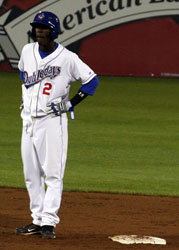30. Michael McDade, 1B
Born May 8, 1989. Selected in the 6th round of the draft.
| Year | Age | Level | AB | 2B | 3B | HR | BB | K | SB | CS | AVG | OBP | SLG |
| 2008 |
19 |
A- |
191 |
8 |
1 |
3 |
22 |
53 |
1 |
0 |
.257 |
.333 |
.287 |
| 2008 |
19 |
A |
216 |
13 |
0 |
2 |
11 |
63 |
0 |
0 |
.194 |
.236 |
.282 |
| 2009 |
20 |
A |
408 |
27 |
1 |
16 |
32 |
109 |
0 |
0 |
.277 |
.336 |
.466 |
| 2010 |
21 |
A+ |
480 |
22 |
1 |
21 |
27 |
141 |
2 |
0 |
.267 |
.315 |
.448 |
After a decent year in A ball in 2009, McDade had a consolidation year in 2010, putting up decent numbers in the tough on hitters Florida State League. A big (and I mean big) switch hitting masher, McDade doesn't make a ton of contact and when he does the ball usually is traveling pretty fast. When he isn't hitting the ball hard it isn't pretty though, as he has never walked much and was particularly bad in 2010. His strikeouts are also trending upwards, which is probably not a good sign. He is still relatively young at 21, but has never really had a "wow" season to put him on the radar as a serious prospect. He figures to start 2011 in Dunedin again (barring a surprise promotion) and will need to improve upon his plate discipline if he is to have any chance of continuing to advance through the system.
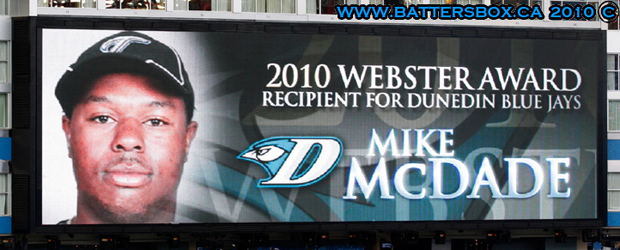
29. Marcus Knecht, OF
Born June 21, 1990. Selected in the 3rd round of the 2010 draft.
| Year | Age | Level | AB | 2B | 3B | HR | BB | K | SB | CS | AVG | OBP | SLG |
| 2010 |
20 |
A- |
231 |
18 |
3 |
5 |
26 |
48 |
7 |
1 |
.268 |
.345 |
.437 |
The Blue Jays drafted North York’s own Marcus Knecht in the 3rd round of this summer’s draft. Knecht comes to the organization via the Ontario Blue Jays, Oklahoma State, Connors State (in Oklahoma) and the Team Canada juniors. He initially went to play college ball at OSU, but received only 12 plate appearances in 2009. He subsequently transferred to Connors State in 2010, where he hit .353 and joined a host of other Canadian alums, including former Blue Jays farmhand and Etobicoke native Kyle Gilligan. Knecht had been on the Jays radar even before a strong 2009; Scouting director Andrew Tinnish saw Knecht win the Hit-Run-Throw program as an 11-year-old and also has connections to Knecht through the Ontario Blue Jays.
After signing Knecht was sent to Auburn and played in 61 games for the Doubleday, hitting .268/.345/.437 with 18 doubles, 3 triples and 5 home runs, good for fourth best slugging percentage on the team. He has good speed, having been clocked in at 6.54 seconds in the 60-yard dash, and displayed good instincts on the bases, stealing successfully in 7 of 8 attempts. Knecht played left field exclusively at Connors State but played mostly in right for the Doubledays, starting 25 games there and splitting the other 16 games between centre and left. His arm is apparently mediocre, so his likely position in the majors is left field.
If Knecht is going to make the big leagues it will be his bat that carries him; despite mixed prior reports his power emerged as a viable major league tool in 2010. He possesses gap power, as his double total attests, and he has a reasonably strong batting eye, although he can get over-aggressive, as was reportedly the case at Oklahoma State when he was pressing to get playing time. He has good bat speed and an aggressive swing, though it can look long and is somewhat unorthodox. One potentially positive note is that, as a Canadian, Knecht has less baseball experience than many of his American and Latin American teammates, so there may be more room for him to develop. Knecht will probably begin the year in Lansing, with a chance to progress to Dunedin by the end of the year and he should continue to move through the system as long as he keeps hitting.
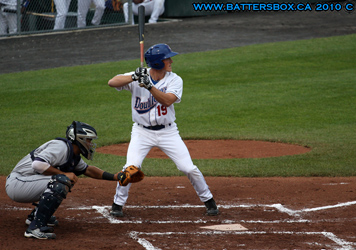
28. Gustavo Pierre, SS
Born December 28, 1991. Signed as an international free agent in 2008.
| Year | Age | Level | AB | 2B | 3B | HR | BB | K | SB | CS | AVG | OBP | SLG |
| 2009 |
17 |
Rk |
174 |
10 |
4 |
4 |
3 |
45 |
8 |
5 |
.259 |
.272 |
.431 |
| 2010 |
18 |
A- |
250 |
12 |
3 |
3 |
17 |
64 |
8 |
4 |
.236 |
.283 |
.344 |
The Blue Jays signed Pierre (pronounced pee-a-ray) out of the Dominican Republic in 2008. Shortly thereafter Pierre needed Tommy John surgery and his professional debut was pushed back to 2009 in the GCL. In 2010 Pierre was assigned to Auburn in the NYPL and he had a good season there for an 18 year old. He started slowly and had an OPS of .437 in July but in August Pierre bumped that to .732 and finished his few September games with an OPS of .783. Plate discipline was a big part of his improvement at the plate; Pierre walked five times in his first thirty-seven games and twelve times in his next twenty-four.
Physically Pierre is a big strong kid who shows power potential in batting practice. As with many young players his power had not shown yet in games but the projection is there. Defensively Pierre made a lot of errors in 2010, twenty-nine. This is not unusual for a young shortstop prospect but observers feel that Pierre is not playing defense with a lot of confidence and he has played tentatively. More professional experience might alleviate that concern. Ultimately some scouts believe Pierre may end at third, where his bigger size and strong arm can be an asset.
Pierre will likely play next season in the Midwest League as a nineteen year old. As long as his offense progresses Pierre should move up this prospect list.
27. Griffin Murphy, LHP
Born January 16, 1991. Selected in the 2nd round of the 2010 draft.
| Year | Age | Level | G | GS | IP | H/9 | HR/9 | BB/9 | K/9 | ERA |
| 2010 |
19 |
HS |
15 |
--- |
73.0 |
5.67 |
--- | 2.47 |
12.82 |
1.35 |
Murphy was the 61st overall selection in the 2010 amateur draft from Redlands East Valley High School in California. He turned down a scholarship from the University of San Diego to sign a deal with the Jays that included an $800,000 signing bonus. The 6-foot-3, 200-pound lefty won 11 of 12 decisions with a 1.35 earned run average and a save in his senior season, striking out 104 batters and walking just 20 in 72 2/3 innings. He also batted .333 with three home runs and 21 runs batted in. Baseball America rated Murphy the highest-rated prep southpaw for the 2010 draft and placed him on its 3rd Team High School All-America squad.
Various scouting reports have said he throws a fastball in the 89-93 MPH range and possesses an average to above-average curveball and changeup. Baseball America says Murphy can command his fastball to both sides of the plate by running it in, running it away, sinking it and turning it over. His curve is said to have good sweep with two-plane movement but he does tend to leave it up and needs to improve its depth. Though none of his pitches are graded as plus, his mechanics are described to be “relatively solid”. The 19-year old is said to have a delivery that is similar to Angels lefty Scott Kazmir and a build like Phillies southpaw Joe Blanton.
Murphy also has a good work ethic off the field as he laundered his teammates clothing to earn extra spending money and he plans to take online courses to obtain a university degree while he pitches in the minors. Projected as a mid-rotation starter in the bigs, Murphy will probably launch his pro career in the Gulf Coast League.
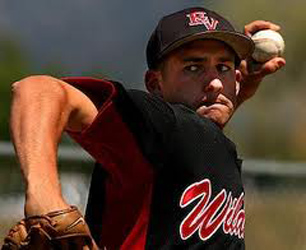
26. Dickie Joe Thon, SS
Born November 16, 1991. Selected in the 5th round of the 2010 draft.
Dickie Thon Jr. was a surprise signing in the 5th round. He apparently came with a strong commitment to Rice University, and an agent-father who didn't like the way MLB clubs were approaching his son. "What upset me was the gamesmanship, how they didn't shoot straight... I don't like the way Toronto treated him in the draft."
Well, maybe former all-star Thon Sr. was engaging in a little gamesmanship of his own, because the Jays shelled out $1.5 million, more than 12 first-rounders received, to pry his son away from Rice.
We won't likely be seeing Thon at the big league level for many years - several analysts consider him raw and, before signing, suggested that college development would be good for him. Regardless, he clearly has excellent tools to have received such a high bonus, and some of those tools mentioned by prospect gurus include speed and arm strength. Despite his size (6'2"), most scouts seem to think he can stay at shortstop, and perhaps be above-average defensively. He's an "above-average hitter" (whatever that means - above average for a Puerto Rican high school player?) but his pitch recognition could use some refinement.
All in all, your classic toolsy high school project. Seeya in 2016, Dickie Joe!
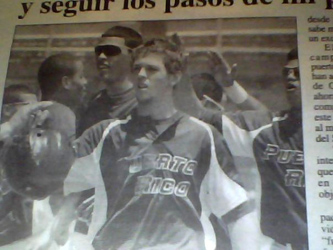
25. Brian Jeroloman, C
Born May 10, 1985. Selected in the 6th round of the 2006 draft.
| Year | Age | Level | AB | 2B | 3B | HR | BB | K | SB | CS | AVG | OBP | SLG |
| 2008 |
23 |
AA |
226 |
15 |
0 |
6 |
47 |
47 |
0 |
0 |
.270 |
.396 |
.416 |
| 2008 |
23 |
AAA |
75 |
2 |
0 |
0 |
11 |
17 |
0 |
0 |
.200 |
.302 |
.227 |
| 2009 |
24 |
AA |
364 |
16 |
1 |
6 |
62 |
120 |
1 |
0 |
.217 |
.330 |
.316 |
| 2010 |
25 |
AA |
245 |
16 |
0 |
7 |
69 |
92 |
0 |
1 |
.261 |
.429 |
.412 |
| 2010 |
25 |
AAA |
19 |
3 |
0 |
2 |
8 |
10 |
0 |
0 |
.316 |
.519 |
.789 |
Despite vastly increased depth in the system, Jeroloman managed to break back into the Batters Box Top 30 with a strong 2010. Our number 16 prospect in 2007 (between Justin Jackson and Chi-Hung Cheng) and number 12 prospect in 2008 (between Eric Eiland and John Tolisano... remember those guys?), Jeroloman struggled mightily in 2009, hitting .217/.330/.316 in his second go round in New Hampshire, walking less and striking out more, 14.4% and 33.0% of the time, respectively. Jeroloman has never put the ball in play much, and 2010 continued that trend, as he boosted his walk rate to an otherworldly 21.6%, while his strikeout rate also continued to an outsized level, hitting 37.1% for the year. Cumulatively he put the ball into the field of play (i.e. not a homer, K, BB or HBP) 146 times in 319 plate appearances, or 46% of the time, and he had 57 hits, for a BABIP approaching .400.
While his numbers are certainly not sustainable, Jeroloman value has never been tied up in his average, and he has definite major league skills as a good defender and an on base machine. In 1036 AA plate appearances he is a .244/.379/.371 hitter, and has essentially established what kind of player he will be at this juncture - a low average hitter with a great eye and a bit of pop - a decent backup or a stretched starter in the bigs. While he figures to open 2011 in Las Vegas, Jeroloman may have to go elsewhere to get his chance to make the show. There are 4 other catchers well ahead of him of him in the prospect rankings, including J.P. Arencibia, who figures to open next year in Toronto and (hopefully) stay there for a while, so a trade may be Jeroloman's only chance to break into the majors.
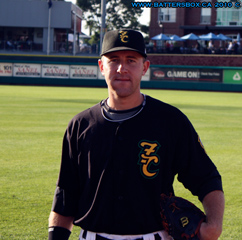
24. Trystan Magnuson, RHP
Born June 6, 1985. Selected in the supplemental 1st round of the 2007 draft.
| Year | Age | Level | G | GS | IP | H/9 | HR/9 | BB/9 | K/9 | FIP |
| 2008 |
23 |
A |
24 |
24 |
81.2 |
10.03 |
0.66 |
3.86 |
5.40 |
4.50 |
| 2009 |
24 |
A+ |
38 |
0 |
61.2 |
8.17 |
0.29 |
3.94 |
6.57 |
3.67 |
| 2009 |
24 |
AA |
5 |
0 |
10.0 |
3.60 |
0.00 |
0.90 |
6.30 |
2.10 |
| 2010 |
25 |
AA |
46 | 0 |
73.1 |
8.59 |
0.12 |
1.23 |
7.33 |
2.15 |
The 25 year-old Vancouver native took another step closer to big league employment in 2010. Mel Queen, the Jays senior advisor of player development, got the 6-foot-7, 200 pound righty to throw a split-finger fastball like a fastball instead of a changeup. As a result, Magnuson now throws a cutter, a splitter, a two-seam fastball in the 90-94 MPH range along with a slider. That helped Magnuson put up an excellent season at Double-A New Hampshire where he posted a 3-0 record, a K-BB ratio of over 6:1 and allowed just one home run all season. His performance with the Fisher Cats earned him a berth on the World Team for the 2010 Futures Games in Anaheim. Magnuson has come a long way from his pro season in Lansing in 2008 when he posted an 0-9 record as a starter.
In a National Post article earlier this season, he attributes his never-say-die attitude on the mound to his late uncle, former Chicago Blackhawks defenceman Keith Magnuson.
“My uncle was not the most skilled player but he played hard and wanted to win. They needed an enforcer so he fought. That was his role. He lost a lot of fights but he always got right back up and continued to do his job. I’ve had bad outings where I haven’t been effective and it hurt my ERA, but I have not taken a loss. (Keith) went after people every night with everything he had. I’ve lost a lot. I got cut in high school, but I keep coming back and will always do everything it takes to win.”
Magnuson had spent five years in Louisville and was the closer for the Cardinals College World Series squad in 2007. The 56th overall pick in the 2007 amateur draft signed for a $462,500 bonus, but did not begin his career until 2008 as he had a sore elbow. He is now pitching for Team Canada at the Pan Am Games qualifying tournament in San Juan, Puerto Rico. Given the uncertainty of who will be in the Jays bullpen in 2011, a good spring could see Magnuson begin the year in Toronto. If not, the engineering graduate will probably be ticketed for the bullpen at Triple-A Las Vegas.
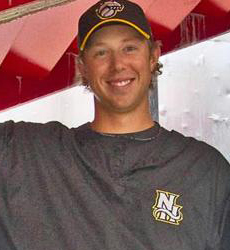
23. Drew Hutchison, RHP
Born August 22, 1990. Selected in the 15th round of the 2009 draft.
| Year | Age | Level | G | GS | IP | H/9 | HR/9 | BB/9 | K/9 | ERA |
| 2010 |
19 |
A- |
10 |
10 |
45.0 |
6.80 |
0.20 |
2.40 |
8.80 |
3.00 |
| 2010 |
19 |
A |
5 |
5 |
23.2 |
6.46 |
0.38 |
2.66 |
7.23 |
1.52 |
Hutchison is a perfect example of solid scouting. The Jays organization drafted him in the 15th round of the 2009 draft and gave him an above-slot deal at the signing deadline based on projection. Hutchison throws from a low-three-quarters arm slot with an average fastball (87-92 mph), slurvy breaking ball and changeup. The Florida native didn't toss his first official pro pitch until 2010 but he was impressive nonetheless. He began the year in short-season Auburn (New York Penn League) and posted a 2.60 FIP (3.00 ERA) in 10 starts. He gave up just 34 hits in 45.0 innings. His ground-ball rate of 64% was outstanding. Hutchison displayed solid control, as well, with a walk rate of 2.40 BB/9. He whiffed batters at a rate of 8.80 K/9. Moved up to Lansing, he held batters to a .203 average in 23.2 innings and his walk rate remained solid at 2.66 BB/9. His ground-ball rate dropped to 46% in the small sample size and he should return to the level for 2011.
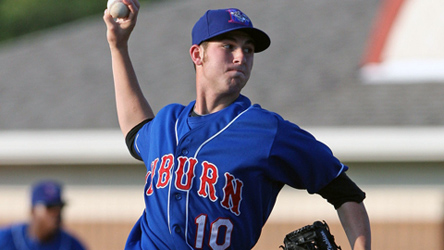
22. Danny Farquhar, RHP
Born February 17, 1987. Selected in the 10th round of the 2008 draft.
| Year | Age | Level | G | GS | IP | H/9 | HR/9 | BB/9 | K/9 | ERA |
| 2008 |
21 |
A- |
12 |
0 |
26.1 |
6.84 |
0.34 |
2.05 |
9.23 |
2.39 |
| 2008 |
21 |
A |
3 |
0 |
6.0 |
0.00 |
0.00 |
3.00 |
6.00 |
0.00 |
| 2009 |
22 |
A+ |
17 |
0 |
17.0 |
5.29 |
0.00 |
5.82 |
12.18 |
0.53 |
| 2009 |
22 |
AA |
37 |
0 |
45.2 |
6.11 |
0.20 |
5.91 |
10.05 |
2.36 |
| 2010 |
23 |
AA |
53 |
0 |
76.2 |
5.87 |
0.82 |
4.93 |
9.27 | 3.52 |
Danny Farquhar didn’t have a particularly good year in 2010, posting the highest ERA of his professional career, but he remains one of the team’s top relief prospects because of a strong second half and his unique delivery. Farquhar is a sidewinder who throws from multiple arm angles. He throws side-armed in the high eighties to low nineties, over the top, where he can reach 95, and with a three-quarters delivery, which explains the difficulty many hitters seem to have in making solid contact off him.
Going into 2010 Farquhar had only allowed one home run in each of his two minor league seasons. This year, however, Farquhar allowed 7 in 76.2 innings. His true ability is probably somewhere in between the two seasons, as 2% of his fly balls went for home runs in 2009 and 10% of his fly balls went for homers in 2010. Farquhar’s fly ball rate has been relatively consistent, holding between 31-33% over the past couple of years. His home run rate this year may be somewhat of a fluke, although it may not decrease to previous levels. However Farquhar's ground ball rates did dip in 2010, falling to 46.6% after two years over 50%. In addition, despite never seeming to struggle a great deal with his control during his college season or his first year of professional baseball, his walk rate skyrocketed to 5.9/9 in 2009 and, although it improved, it remained high at 4.9/9 in 2010.
Despite all this the second half of 2010 represented a noticeable improvement for Farquhar and hopefully represents a step forward for the youngster. From April to June, Farquhar threw 36 innings, striking out 35 and walking 29. In July through September, Farquhar threw 45.2 frames, striking out 47 and walking 15. Another positive sign is that Farquhar continued to be difficult to hit, surrendering less than 6 hits per 9 innings for the third straight season. Of all New Hampshire pitchers who threw over 20 innings, Farquhar’s H/9 was the third-lowest, behind Tim Collins and 29-year-old BJ LaMura. In fact, his H/9 was the fourth-lowest in the entire Eastern League.
While all the caveats about minor league relievers apply, Farquhar will likely have an opportunity to crack a somewhat revamped Toronto bullpen in 2011, whether it is in April or, more likely, in August or September.
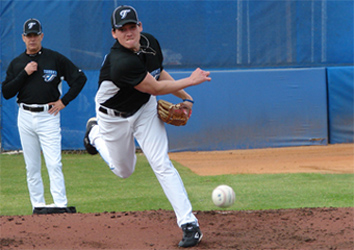
21. Noah Syndergaard, RHP
Born August 29, 1992. Selected in the supplemental 1st round of the 2010 draft.
| Year | Age | Level | G | GS | IP | H/9 | HR/9 | BB/9 | K/9 | ERA |
| 2010 |
18 |
R |
5 |
5 |
13.1 |
7.43 |
0.00 |
2.70 | 4.05 |
2.70 |
Syndergaard was a fast mover this past spring as his fastball velocity jumped significantly during his senior year of high school. The tall right-hander from Texas also displayed an improved curveball and he continued to work on his changeup in the fall instructional league after signing with Toronto. Syndergaard signed quickly enough to appear in five games with the Gulf Coast League Jays. He posted a 3.20 FIP (2.70 ERA) in a small sample size (13.1 innings) and showed good control for his age with a walk rate of 2.70 BB/9. His strikeout rate was just 4.05 K/9. His velocity was down a bit in his debut but he may have tired. Prior to signing, Syndergaard's slightly-altered arm slot would tip off whether he was throwing a fastball or breaking ball. He could stand to incorporate his legs/lower half into his delivery a little more; his delivery - prior to signing - put a lot of stress on his back and shoulder. Depending on his showing in extended spring training, Syndergaard should open the season in either Bluefield (Appy League) or Vancouver (Northwest League). He's likely to be a long-term project.
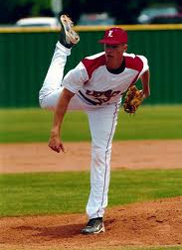
Up Next: Prospects 20-11




